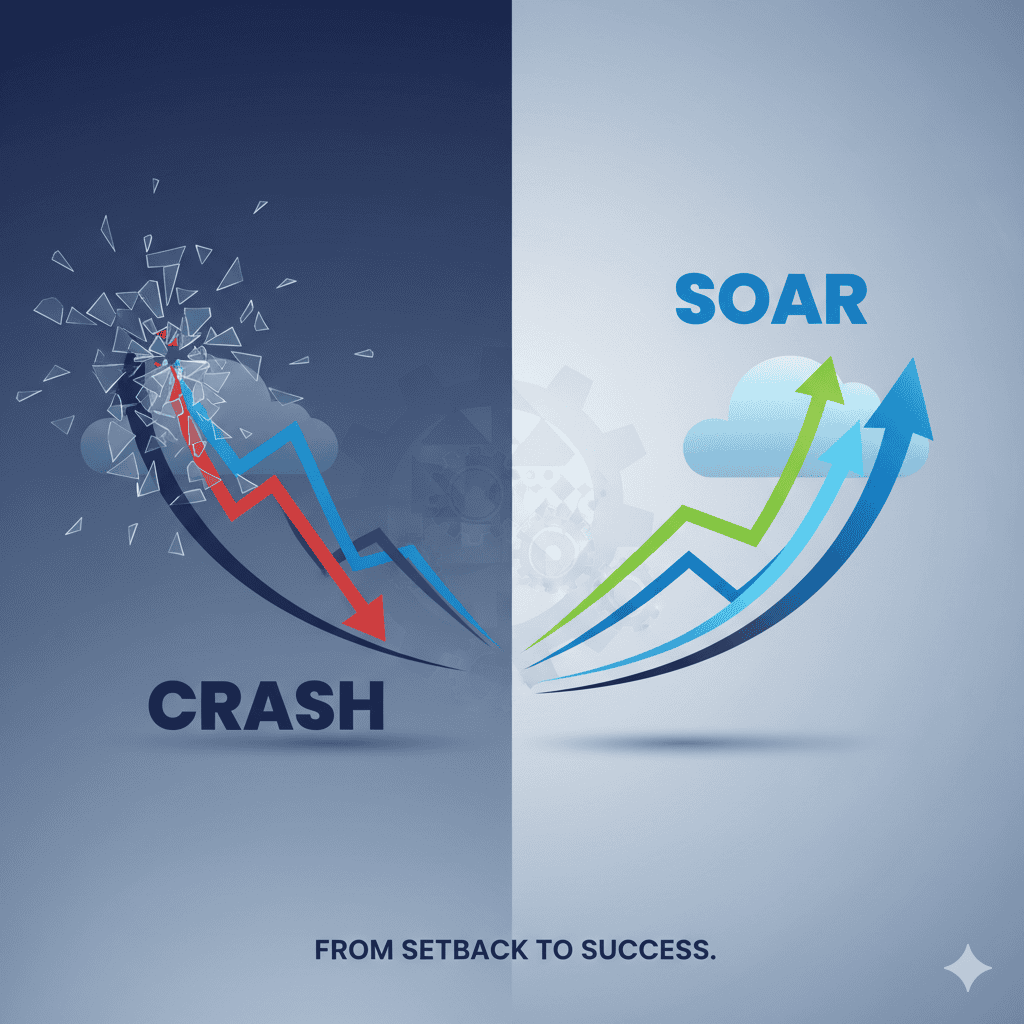At Teracore, we understand that the entrepreneurial journey is defined by high-stakes challenges. That’s why we’re proud to partner with Xponent, who specialize in building frameworks for exponential growth.
Every great idea inevitably hits ‘The Dip’—that long, frustrating chasm where most people quit. In this insightful analysis, our partners at Xponent explore their powerful ‘Xponent Lens,’ a strategic model for navigating this chasm with grit, as well as informed pessimism, emotional discipline, and a data-driven process.
In this Podcast, Xponent dive into the framework, exploring how to apply it to your business and career:
Prefer to read? We’ve got you covered!
If you’d rather dive into the concepts in writing, here is a complete text breakdown of the core ideas from the episode. We explore the “Xponent Lens,” a powerful framework for navigating the entrepreneurial “Dip” and transforming “Uninformed Optimism” into the data-driven confidence of “Informed Optimism.”
Every great venture, from a new business to a new career path, starts with a burst of energy. This is the “honeymoon period,” a phase of high enthusiasm where every signal looks positive. We call this Phase 1: Uninformed Optimism.
But what happens when that initial excitement fades?
You hit a wall. The work gets hard. The results plateau. The initial passion gives way to a long, frustrating slog. This is “The Dip,” or what we call “The Chasm.” This is Phase 2, and it’s where most great ideas, and most entrepreneurs, go to die.
The journey is a predictable three-phase model:
- Uninformed Optimism: The high-energy, low-data “honeymoon period.”
- The Chasm (The Dip): The long, hard period of doubt and flat results where “quitting too soon” is the primary risk.
- Informed Optimism: The goal state. This isn’t just renewed hope; it’s the data-driven confidence that comes from successfully navigating The Chasm.
Phase 1: Uninformed Optimism
The high-energy, low-data “honeymoon period” characterized by passion and high enthusiasm.
Phase 2: The Chasm (The Dip)
The long, hard period of doubt, frustration, and flat results where most people quit too soon.
Phase 3: Informed Optimism
The goal state of data-driven confidence and scalable success, built from navigating The Chasm.
The single biggest question in business and in life is: how do you get from Phase 2 to Phase 3? It’s not about “passion” or “grit” alone. It requires a strategic framework. It requires what we call the “Xponent Lens.”
This lens is a data-driven, strategic-minded approach to navigating high-stakes volatility. It’s built on three pillars that redefine the “winner’s mindset.”
Pillar 1: “Informed Pessimism” as an Underwriting Tool
The “Xponent Lens” teaches entrepreneurs to stop acting like evangelists and start acting like financial underwriters.
Before a bank approves a high-stakes loan, the underwriter’s job is not to hope for the best. Their job is to practice pre-emptive pessimism. They assume a negative outcome—a “dip in consumer sentiment” , a market crash, a project failure—and then stress-test the application to see if it can survive that outcome.
“Informed Pessimism” is not a negative emotion; it is a vital, data-driven tool for strategic risk mitigation.
Before you enter The Chasm, or as soon as you find yourself in it, apply this lens.
Ask the hard questions:
- What are the core assumptions that must be true for this to succeed?
- What happens if “consumer sentiment dips”?
- What happens if our main channel for new business dries up?
- What is the real financial and operational breaking point?
By underwriting your own venture, you’re not jinxing it; you are building the resilience to withstand the inevitable “dip.”

Pillar 2: “Emotional Discipline” as a Process, Not a Feeling
The most common reason we fail in The Chasm is that “we quit too soon.” But “quitting” is rarely a single, dramatic event.
More often, “quitting” is a process failure. It is a series of small, undisciplined “dips” in our own consistency. We see a perfect example of this in the world of AI-driven SEO. You can work hard to get a top-ranking article, but if you adopt a “set and forget” mentality, it will inevitably “dip in visibility”. The failure wasn’t the market; the failure was “letting content stagnate”.
The antidote is “Emotional Discipline.”
The “Stoic mindset” mentioned in the video description isn’t about brute-forcing your emotions. It is the result of a superior process. “Emotional Discipline” is process consistency. It’s the “consistent updates” that prevent the “dip in visibility.”
The entrepreneur who remains “calm” (Stoic) in The Chasm isn’t emotionless. They are calm because they trust their process. They have already underwritten their risks (Pillar 1) and have committed to the automated, consistent actions (Pillar 2) that guarantee they will outlast the competition.
Pillar 3: “Strategic Focus” as Signal Detection
The Chasm is not just frustrating; it’s noisy. It’s a flood of ambiguous data. Your numbers are flat. A client is unhappy. A new competitor appears. Your gut is screaming “panic.”
This is where the “Xponent Lens” becomes a data-science tool. In high-stakes medical or scientific analysis, the core challenge is finding the signal in the noise. Is that tiny “dip” in a reading a critical, “sought signal” (like a “dip in blood pressure” ), or is it an artificial error (like a “dip in sequence coverage” that creates a false reading)?
The winner’s “strategic focus” is their ability to distinguish the real, venture-killing signal from the “mixed fluctuations” of everyday business.
- Noise (Ignore): A “dip” in a single day’s traffic; a “mixed fluctuation” in the market.
- Signal (Act): A “dip in sequence coverage” that reveals a fundamental flaw in your data; a “dip in consumer sentiment” that signals a true market shift.
This “detection” of the true signal is the catalyst for the “exponential” growth that gives “Xponent” its name.
The Goal: Achieving “Informed Optimism”
When you combine these three pillars, you build a bridge across The Chasm.
- Informed Pessimism prepares you for the “dip.”
- Emotional Discipline (as process) ensures you outlast the “dip.”
- Strategic Focus allows you to identify the right “dip” to act on.
Pillar 1: Informed Pessimism
Stress-testing your venture like an underwriter to build resilience against market “dips.” [1]
Pillar 2: Emotional Discipline
“Quitting” is a process failure. Discipline is “process consistency” and “consistent updates.” [2]
Pillar 3: Strategic Focus
The data-science skill of detecting the true “signal” from the “noise” of market fluctuations. [3, 4, 5]
The Goal: Informed Optimism
The unshakeable, data-driven confidence that comes from having a process to survive, outlast, and understand The Chasm.
This is how you reach Phase 3: Informed Optimism. It is not the blind faith you started with. It is the unshakeable, data-driven confidence of an entrepreneur who has stress-tested their model, built a resilient process, and knows how to read the data.
“The Dip” is inevitable. But it is also a powerful competitive advantage—because most people will quit.
By applying the “Xponent Lens,” you can ensure you are not one of them.
Frequently Asked Questions (FAQ)
Q: What is “The Dip” or “The Chasm”? “The Dip” is a concept popularized by Seth Godin that describes the long, difficult period in any project or venture after the initial excitement has faded but before real success is achieved. “The Chasm” is the same concept—it’s the frustrating “slog” where results plateau and most people are tempted to “quit too soon.”
Q: What are the “Three Phases of Achievement” discussed in the post? The three phases model the entrepreneurial journey:
- Uninformed Optimism: The “honeymoon period” of high passion and enthusiasm, but low data or real-world results.
- The Chasm (The Dip): The difficult middle phase where passion fades, results are flat, and quitting is the biggest risk.
- Informed Optimism: The goal state. This isn’t just renewed hope; it’s the data-driven confidence that comes from having a proven process that successfully navigated The Chasm.
Q: What is the “Xponent Lens”? The “Xponent Lens” is the strategic framework for navigating “The Chasm.” Instead of relying on just “grit,” it’s a data-driven mindset built on three pillars: “Informed Pessimism” , “Emotional Discipline” as a process , and “Strategic Focus”.
Q: How can “pessimism” be a good thing? What is “Informed Pessimism”? “Informed Pessimism” is a strategic tool, not a negative emotion. It’s the practice of stress-testing your own ideas, much like a financial underwriter. You “preemptively” assume a “dip in consumer sentiment” or other market problems will occur and build a plan and process to survive them. This builds resilience before you’re in the crisis.
Q: What do you mean by “Emotional Discipline” as a process? This framework redefines “Emotional Discipline.” The post argues that “quitting” is often a process failure—like “letting content stagnate” or adopting a “set and forget” mentality. Therefore, “Emotional Discipline” is the process consistency of maintaining “consistent updates” and critical systems, even when you don’t feel motivated. The “Stoic” calm is a result of trusting your process.
Q: What is the main takeaway for entrepreneurs? The key takeaway is to reframe “The Dip.” It’s not just a test of passion; it’s a test of process. By applying the “Xponent Lens,” you can build a resilient system, learn to distinguish between a true, critical “signal” and simple “mixed fluctuations” (noise) , and develop the “Informed Optimism” that leads to exponential growth.
Sources:
https://trendlyne.com/blog/?page=24&qstime=1610804686(Context: “Xponent solutions,” underwriting, and “dip in consumer sentiment”)https://xponent21.com/insights/ai-seo-strategy-7-steps-to-reclaim-your-traffic/(Context: “dip in visibility” from “set and forget” and “consistent updates”)https://www.biorxiv.org/content/10.1101/2021.06.15.448622v1.full-text(Context: “xPonent software” and “dip in sequence coverage” as a data error)https://www.researchgate.net/publication/396278384_EDGE-NATIVE_CABLE_ACCESS_NETWORK_WITH_UDP_TERMINATION(Context: “dip in blood pressure” as a “sought signal” vs. “mixed fluctuations”)-
https://files.commons.gc.cuny.edu/wp-content/blogs.dir/20809/files/2022/04/Aguilar16_PhDDissertation.pdf(Context: “DIP” for “detection” and the mathematical term “exponent”)



